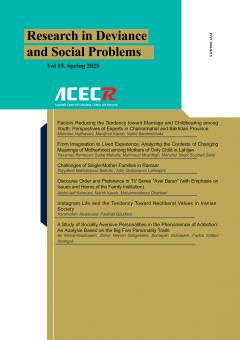-
-
-
Open Access Article
1 - Sociological Study of Marriage Patterns as a Subject of Generational Conflict in Families of Clergy Students from the Children’s Point of View
zahra movahedi saveji mansoure azam azade mahdi etemadi fard -
Open Access Article
2 - Examining the Cohabitation Status in Iran: a Synthesis of Cohabitation Researches
Mohammadjavad Chitsaz -
Open Access Article
3 - Changes in the Family in Contemporary Iran Emphasis on Marriage and Divorce
shahla kazemipuor -
Open Access Article
4 - Pathology of Erotic Marriage (Case Study: Women Applying for Divorce in Tehran City)
Sara Tahmanesh bagher sarokhani Akbar Tahmanesh -
Open Access Article
5 - Sociological Analysis of the Cultural Components of Marriage in Persian Tweets
zahra sheikh Bagher saroukhani khadijeh zolghadr -
Open Access Article
6 - Consequences of Early Marriage Among Women in Ahvaz City
Shamsi Pourabasi jafar kordzanganeh mansour sharifi -
Open Access Article
7 - Factors Reducing the Tendency toward Marriage and Childbearing among Youth: Perspectives of Experts in Chaharmahal and Bakhtiari Province
Mehrdad Hajihasani Manijeh Kaveh Nahid Mandeh Khoda
List of Articles ازدواج
-
The rights to this website are owned by the Raimag Press Management System.
Copyright © 2017-2025

